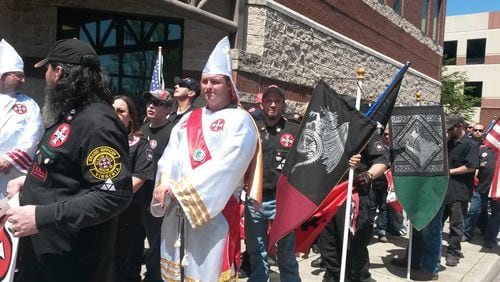It’s been just a year since the mass shooting of churchgoers in Charleston sparked national soul-searching and, in Georgia, a burst of noise from Confederate sympathizers and white supremacists.
But here’s the good news: The fire lit with that bloodshed is out, and people who keep an eye on hate groups say these groups appear to be no larger or better organized than they were a year ago.
“The whole entire white supremacist movement is struggling. The Klan movement is struggling and the whole neo-Nazi movement almost died,” said Carla Hill, an investigative researcher for the Anti-Defamation League’s Center on Extremism.
That's a big change from when extremist groups pounced on the backlash against the Confederate flag last year and tried to recruit new members at a series of public rallies, beginning with one in August at Stone Mountain that drew hundreds.
Most of them gathered under a banner of “heritage not hate,” but true haters were in their ranks. The League of the South, an Alabama-based secessionist organization, claimed a corner of the demonstration and used a P.A. system to make bombastic speeches to a large and enthusiastic crowd.
Subsequent rallies were smaller, but more extreme. People with ties to the Ku Klux Klan and other white power groups took over organizing events and boasting about them on social media.
In April, extremists held twin rallies in different parts of the state. At Stone Mountain, white power groups staged a rally they called "Rock Stone Mountain," while in Rome the National Socialism Movement aligned with Klan members, skinheads and other hard right groups donned their costumes for a show of force there.
Later that night, the groups went to a racist bar in rural west Georgia for an after party that included a flaming cross and swastika.
Less than a year later and Hill and others I spoke to who spend time monitoring hate groups sounded surprised I was asking about Charleston at all. Extremist groups have moved on to stoking fears about more current topics.
“They are focused on Muslims, Syrian refugees, even transgender restrooms,” Hill said. “The Confederate thing has taken a back seat.”
“Charleston is already forgotten,” echoed Spencer Sunshine of Political Research Associates, a progressive think tank that studies the political right, including far right fringe groups.
Using crowds to look bigger
Both Hill and Sunshine said these groups are seizing on the anti-immigrant rhetoric by presidential candidate Donald Trump to inflame their base. But given their track record, it’s unclear what they will get out of it.
Sunshine said neo-Confederate groups got some exposure with the flag rallies, exciting their current membership, but they were unable to grow. When the rallies at Stone Mountain, for instance, became “white power” events, the crowds evaporated.
The best example was "Rock Stone Mountain." The white power rally was trumpeted for months online but only a bare handful of actual white supremacists showed up. The real story of that event was the hundreds of counter-demonstrators who clashed with police for hours trying to get face to face with the Rock Stone Mountain group.
Hill and Sunshine were both more interested in the National Socialist Movement rally in Rome. The 100 or so demonstrators made it one of the larger extremist rallies in recent years.
But Hill said even that rally showed the group’s weakness rather than its strength. To bolster its number the National Socialist Movement, a neo-Nazi group, signed an agreement with other groups. As a result the protest was a grab bag of hate groups banding together to appear larger, she said.
“They know they can’t get it together so they are trying to form an alliance to make them look bigger,” she said. “That’s the trend now.”
The ADL's most recent accounting puts the Klan at around 30 "mostly small, disjointed groups" that lack consistent leadership and a total, nationwide membership of about 3,000.
Rise in online extremism
Not everybody reckons the strength of hate groups the same way. The Southern Poverty Law Center calculates that hate groups increased by 14 percent in 2015.
“It’s close to 900 (groups) now,” said SPLC president Richard Cohen. “It’s very high historically.”
The center's count of hate groups is published online in the form of an annual "Hate Map," with geographic pins for each group.
The center’s yearly accounting of hate groups gets regularly criticized by people from across the political spectrum. It includes generally recognized hate groups like the KKK and neo-Nazis, but it also includes more mainline organizations like the conservative Family Research Council and religious groups like the Nation of Islam.
Cohen stands by the count. “The hate map is just one index, a barometer of the hate in our country,” he said.
Groups listed don't have to engage in violence to be listed. Intolerance based on race, ethnicity, religion or sexual orientation earns a pin. By their count, Georgia saw a 40 percent increase in hate groups last year. But a closer look at the center's list raises questions.
For starters, the center lists The International Keystone Knights of the Ku Klux Klan as a “new” group. That group has had a Georgia chapter at least since 2012 when it famously sued the state over the denial of is application to adopt a portion of a north Georgia highway.
The center’s list also includes a handful of “bookstores” run by remnants of the Nuwaubian religious cult that once had a compound in Eatonton, but that sect is largely dissembled and the bookstores track back to P.O. boxes.
The list also includes the Aryan Nations Worldwide in Villa Rica. Hill, the ADL investigator, said the group is real, but it has fewer than a dozen members and takes over for a similar group that folded its tent in Louisiana. Registration for the group’s website tracks back to a Louisiana address.
Cohen said size of traditional groups is not the only measure of hate. Online extremism is very powerful. “You don’t have to go to a Klan rally to get your fill of hate. You can get it online,” he said.
After all, he said, that’s what accused Charleston shooter Dylann Roof did.
About the Author







